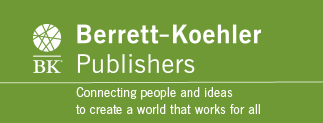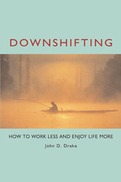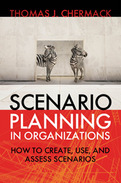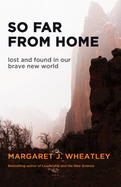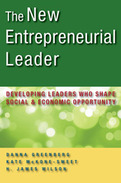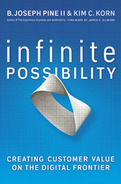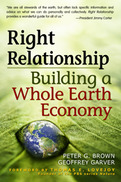2001
-
Offers a comprehensive review of both the theory and practice of scenario planning
-
The only scenario planning book to address scenario implementation and assessment
-
Includes a casestudy to illustrate how the scenario planning system is applied in the real world
Scenario planning helps leaders, executives and decision-makers envision and develop strategies for multiple possible futures instead of just one. It enables organizations to become resilient and agile, carefully calibrating their responses and adapting quickly to new circumstances in a fast-changing environment.
This book is the most comprehensive treatment to date of the scenario planning process. Unlike existing books it offers a thorough discussion of the evolution and theoretical foundations of scenario planning, examining its connections to learning theory, decision-making theory, mental model theory and more. Chermack emphasizes that scenario planning is far more than a simple set of steps to follow, as so many other practice-focused books do -- he addresses the subtleties and complexities of planning. And, unique among scenario planning books, he deals not just with developing different scenarios but also with applying scenarios once they have been constructed, and assessing the impact of the scenario project.
Using a case study based on a real scenario project, Chermack lays out a comprehensive five phase scenario planning system -- project preparation, scenario exploration, scenario development, scenario implementation, and project assessment. Each chapter describes specific techniques for gathering and analyzing relevant data with a particular emphasis on the use of workshops to encourage dialogue. He offers a worksheet to help readers structure and manage scenario projects as well as avoid common pitfalls, and a discussion, based in recent neurological findings, of how scenario planning helps people to overcome barriers to creative thinking.
2012
Combines penetrating insights into the problems and paradoxes of modern society with a fresh perspective on how to persevere in the face of unending challenges using the skills of insight and compassion.
AN INVITATION TO WARRIORSHIP I wrote this book for you if you offer your work as a contribution to others, whatever your work might be, and if now you find yourself feeling exhausted, overwhelmed, and sometimes despairing even as you paradoxically experience moments of joy, belonging, and greater resolve to do your work. This book describes how we can do our good work with dedication, energy, discipline, and joy by consciously choosing a new role for ourselves, that of warriors for the human spirit. This book contains maps of how we ended up in a world nobody wants—overtaken by greed, self-interest, and oppressive power—the very opposite of what we worked so hard to create. These maps look deeply into the darkness of this time so that we can develop the insight we need to contribute in meaningful ways. This book provides maps for the future, how we can transform our grief, outrage, and frustration into the skills of insight and compassion to serve this dark time with bravery, decency, and gentleness. As warriors for the human spirit, we discover our right work, work that we know is ours to do no matter what. We engage wholeheartedly, embody values we cherish, let go of outcomes, and carefully attend to relationships. We serve those issues and people we care about, focused not so much on making a difference as on being a difference.- Winner of the 2013 Nautilus Silver Award in Inner Prosperity/Right Livelihood
- By the bestselling author of Leadership and the New Science, Turning to One Another, and many other inspiring books
- Combines penetrating insights into the problems and paradoxes of modern society with a fresh perspective on how to persevere in the face of unending challenges using the skills of insight and compassion
- Wheatley's most personal work to date, dedicated to alleviating the exhaustion and despair of forward-thinking people
We live in a time of increasing polarization and irrationality, like a Tower of Babel with no distinction between fact and opinion, where information no longer changes minds. In cyberspace, we are bombarded with constant distractions and narcissistic self-making activities. Instant judgment and blame have replaced rational thinking. Organizations are bloated by bureaucracy and meaningless measures. Those working for positive change become exhausted, ill, and heartsick as their good work is ignored, underfunded, or attacked.
We need to acknowledge that we're lost in a world far different that we hoped for. We need new maps to navigate our brave new world. In Leadership and the New Science, Wheatley provided encouraging maps for how to design organizations based on living systems' capacity for inclusion, change, and adaptation. But in the twenty years since that book's publication, she's seen that in spite of our best efforts, the world that has emerged is on a destructive trajectory that won't be reversed by our working harder, finding new methods, or forming better networks.
But Wheatley has not written a book to increase our despair. Quite the contrary. Her intention is to inspire us to do our work with greater resolve and energy, using maps that won't mislead us. So Far From Home offers maps of two kinds. Using the newest of the new sciences, Wheatley shows how different dynamics interacted to create this harsh new world. A second kind of map invites us to choose a new role for ourselves as warriors for the human spirit. We develop the skills we need mostinsight, bravery, decency, compassionas we look honestly at this complex, difficult world. Clarity gives us enduring strength to discover our right work and create meaningful lives in this dark time.
So Far From Home is a startlingly honest, profoundly reflective, and yet paradoxically down-to-earth book rooted in the day-to-day experiences we all share but seen with fresh eyes. It is both affirming and provoking, calling us to reexamine our expectations and redefine our role for the work ahead. It is Wehatley's most personal, heartfelt work to date.
Describes three principles that form the basis for entrepreneurial leadership, a new leadership approach for today's world
In years past, the keywords for leaders were confidence, single-minded purpose, and strategic planning. But today’s vastly complex, globalized, and fast-evolving world requires a different kind of leadership. This game-changing book details a new approach—entrepreneurial leadership—developed at Babson College, the number-one school for entrepreneurship in the world. Entrepreneurial leadership is inspired by, but is separate from, entrepreneurship. It can be applied in any organizational situation, not just start-ups. Based on two years of extensive research, it embraces three principles that add up to a fundamentally new worldview of business and a new logic of decision making. First, rapid change and increasing uncertainty require leaders to be “cognitively ambidextrous,” able to shift between traditional “prediction logic” (choosing actions based on analysis) and “creation logic” (taking action despite considerable unknowns). Guiding this different way of thinking and acting is a new view of business, where simultaneous creation of social, environmental, and economic value is the order of the day. Finally, entrepreneurial leaders leverage their understanding of themselves and their social context to guide effective action. Each chapter offers concrete examples of how educators across all disciplines are integrating these ideas into their courses—and even their entire curricula. The New Entrepreneurial Leader lays out a comprehensive new paradigm for reinventing management education in order to mold leaders who will shape social and economic opportunity.
2011
2009
